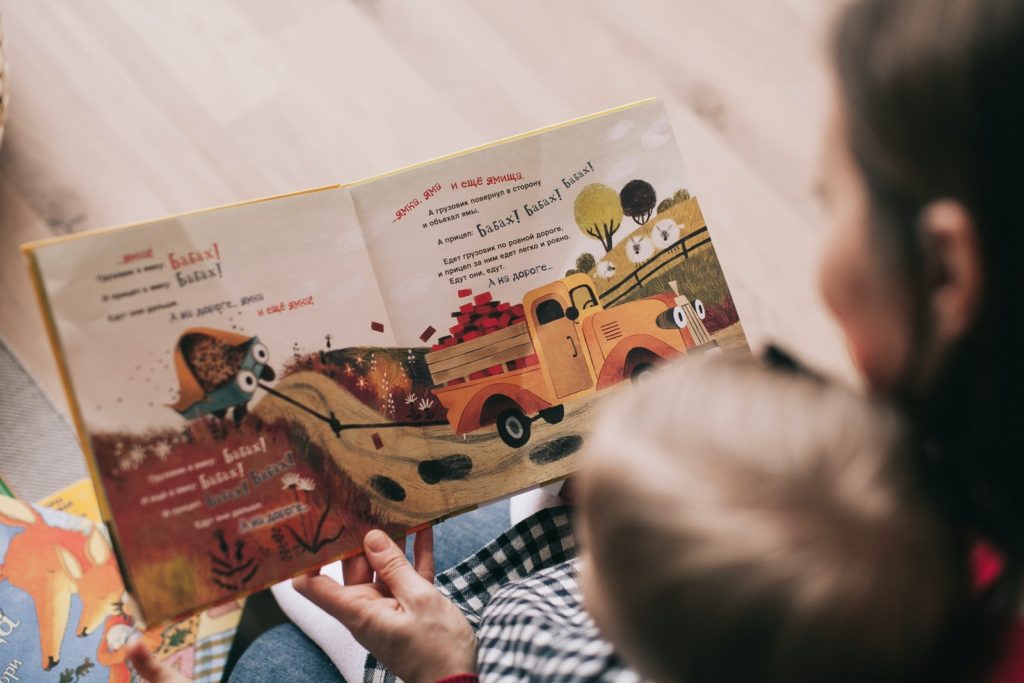
Reading is one of my all-time favorite pastimes. I love picturing the story as though it were a movie, and playing it out in my mind as I read. I love books with rich vocabulary, and I love the imagery, idioms, metaphors, and other figurative languages used in stories. I love predicting what’s going to happen. In short, I love reading. And as a lover of books, I want to instill this love into my children as well, but sometimes it can seem daunting to figure out how to read to your child.
I was recently talking to some peers when one of them said she hated to read to her toddler because it was chaotic, and the child never sat through reading the whole book. I wanted so much to probe further into how she was reading to her baby. And it got me thinking, if this educated woman struggled with reading with her baby, how many others out there struggle because they don’t know what to do? So I wanted to help parents know the ins and outs of reading with your child, starting from a newborn age and up to early elementary education.
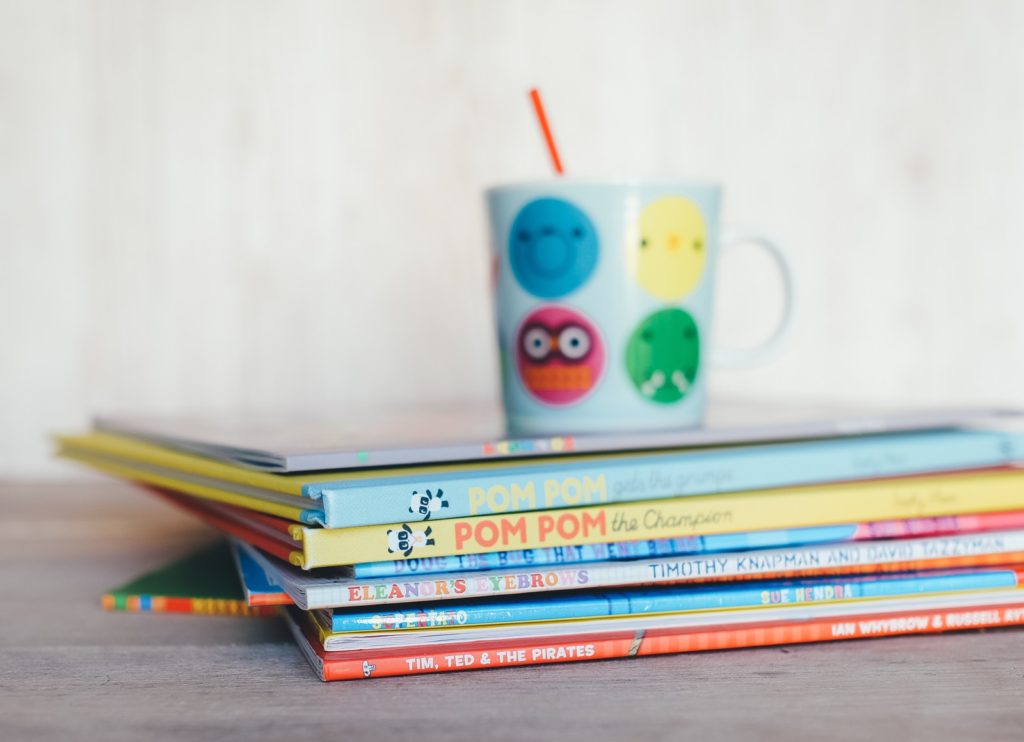
Why is reading with your children important?
First let’s establish why reading to your children is important in the first place. When you read to your children at an early age, it does the following:
- Increases vocabulary – It’s an obvious fact that reading introduces new and more words than just talking. Picture books and board books can introduce rich vocabulary that we may not use in everyday talk. It also gives other words for the same object, for example, I call Nathaniel’s jacket a “coat”, yet his winter story may describe it as a “jacket”.
- Increases attention – Toddlers are constantly on the go. But the more you read, the more you’ll notice that they are able to sit for an extended period of time. Ashley Marcin states in “Reading to Children: Why It’s So Important and How to Start” that, “When they’re listening, they’re more likely to sit still, develop a longer attention span, and even work on their budding memory-retention skills.”
- Develops imagination – Books help develop imagination and creativity! So many stories go beyond the real world and challenge children to think outside of the box. They also present new ideas and concepts for children to think on.
- Helps connect to experiences – One of my favorite things to talk about after reading a story to my kindergarteners was what the story made them think of, or if they had similar experiences as the characters in the story. Reading a variety of books can help children make meaningful connections to their own lives, such as the character in the story used the potty just like your child.
- Sets up for academic success – Truly school isn’t like it used to be when I was a child. I can remember taking most of the year talking about letters. Now, if your kindergartener isn’t reading consistently by the end of the year, they are considered behind age level. Getting an early start on reading with your children exposes them to new words, phonics, print concepts and more!
- Promotes bonding with the family – Slow down, sit down, and grab a book to enjoy some quiet time together! Not only are you getting valuable bonding time with your child or children, but you’re also teaching them a love for reading. Show them your favorite story from your childhood and why it’s your favorite. It may even become their new favorite!
What do I Need?
Really all you need are some really good books of a variety. But the following suggestions can add a little fun before or after reading with your children. These are also all ideas that I used as a kindergarten teacher!
- Books! And in my opinion, lots of them! Have realistic fiction, nonfiction, fantasy, and everything else! Just make sure they are age appropriate.
- Reading area. Children love having special places for things, just like adults. Create a reading nook or corner in the house where your child can easily access books.
- Alphabet and word cards. These can be as simple as index cards with letters written on them. Use them for flashcards or create a memory game.
- Magnetic letters. Use these to start building simple CVC words, such as cat, dog, pig, net, mug.
- Drawing and coloring tools. When your child starts drawing, you can have them draw their favorite part of the story, the main character, and more!
How do I Get Started?
The easiest way to get started is to begin with your bedtime routine. After your child has a bath and is now ready for bed, start reading a story at night if you don’t already. Then, as your child grows older, add in specific reading times. For example, if your toddler has a daily routine of wake up, eat breakfast, independent time, and then nap, carve aside 5-20 minutes during independent play (remember a toddler’s attention span is usually very short, so don’t take too long with it in the beginning) to get in the floor, on the couch, or in the reading nook to read a book.
Now here’s my tips for reading with your child or children for their various ages! Take a look below my points for suggested readings for each age!
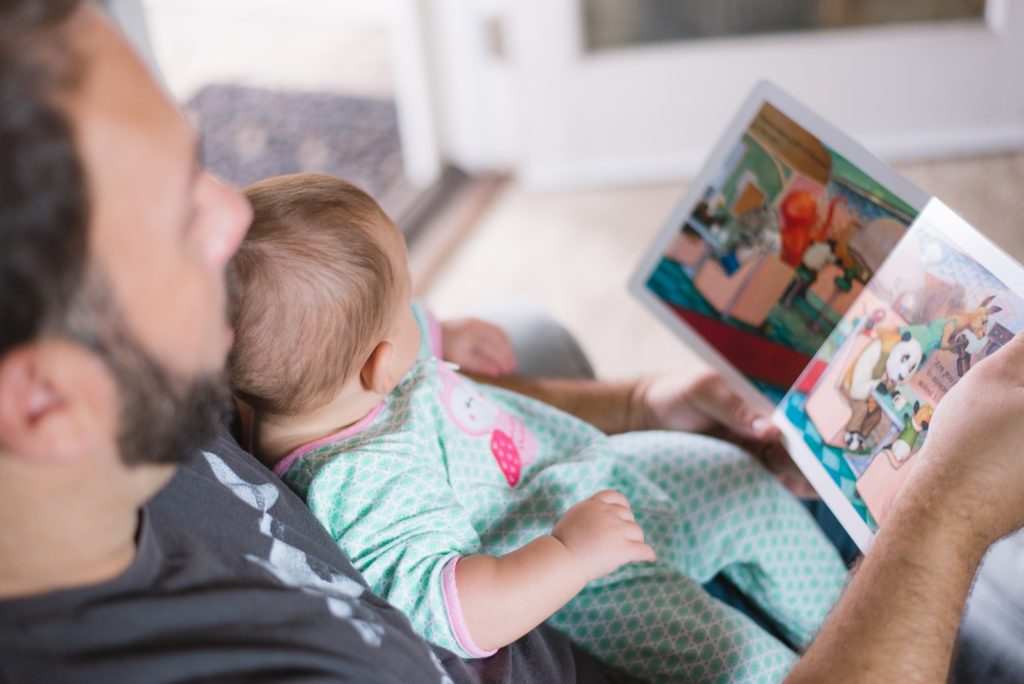
How to read with a newborn to 1 year.
Books
- Choose black and white picture books. Babies love looking at the contrasting colors and shapes.
- Choose colorful picture books.
- Choose books safe for chewing, such as fabric or the indestructible books. Board books hold up better than books with paper pages.
- Create a book with family pictures.
- As babies get older, they love exploring textures. Choose touchy-feely books with fabrics and textures that the baby can feel.
Reading ideas
- If the books you’re going to read have lots of words, you don’t have to read them. Instead, name objects in the pictures.
- Just make up your own version of the story using the pictures. Many times I would just say what was happening in the picture. For example, if you are reading The Three Little Bears, you can describe the pictures like this: there are three bears. The food was eaten. Baby bear is sad.
- Count objects. As your baby gets older, count objects in the picture. Ex: look! There are 3 bears. 1 bear, 2 bears, 3 bears!
- Be dramatic! Babies love when you are expressive, so get animated in the reading.
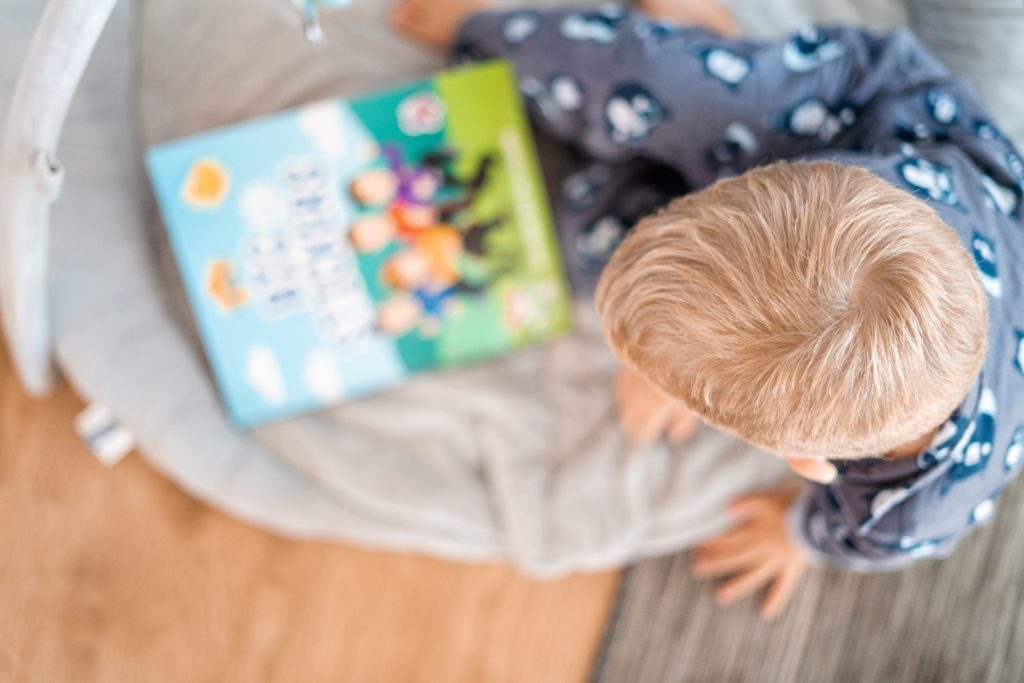
How to read with a toddler.
Books
- Choose books that are interactive. Toddlers love lifting flaps, pushing or pulling parts of the book, touchy feely books, and even pop up books!
- Choose learning books. Read ABC stories, counting to ten stories, and look at color stories. Read 100 word stories and go through each picture as you say the word.
- Books with detailed pictures can give you a lot to discuss with your toddler.
Reading Ideas
- If you are reading a story with detailed pictures, have your toddler point to various objects. Count things in the pictures. Ask what sounds the animals make as you look at the pictures.
- Tell your own version of the story to make it shorter, as toddlers can have short attention spans.
- Sing the story if it’s a nursery rhyme and do the motions if the song has them, such as The Itsy Bitsy Spider.
- Begin tracking the words with your finger. This simply means point to each word as you read it.
Reading Activities
- Flash cards are great for toddlers! Use them to learn letters, letter sounds, numbers, shapes, colors, and beginning words!
- Magnetic letters are wonderful since you can use them for learning letters or numbers, letter shapes, and putting together simple words. Also use them to practice name spelling.
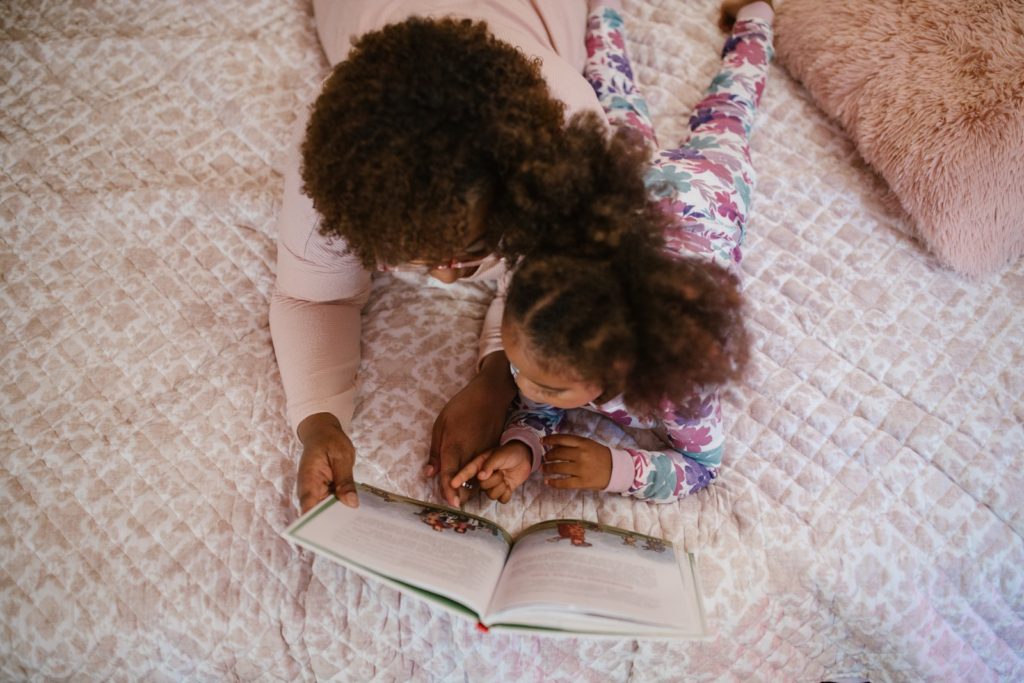
How to read with a 4 year old.
Books
- Nursery rhyme books
- Learning books, such as ABC’s, numbers, counting, colors, and word books.
- Fairytales
- Let your child choose the book that interests him/her. This helps develop that love of reading!
Reading Ideas
- Make predictions about what the book will be about after either looking at the front cover or flipping through the pages.
- If it’s a story your child knows well, instead of reading it to him/her, have your child retell the story using the pictures.
- Sing the nursery rhymes in the book and act out the motions.
- If the story rhymes, have your child guess the second rhyme. For example, you could sing this song and leave out the last rhyme word:
“twinkle twinkle little star, how I wonder what you _____.” - Point out features of a book (title, front cover, back cover, title page, how we read left to right, top to bottom, and how we turn pages).
Reading Activities
- Create or play a name puzzle for your child to practice spelling and reading his/her name.
- Play rhyme games! Say two words and have your child rhyme with those words (ex: cat, hat, _____). Say two words and ask your child to say whether they rhyme or not (ex: cat, box). Give 3 words and have your child tell you the word that doesn’t rhyme (cat, dog, log). Say 3 words and have your child tell you which 2 rhyme (ex: pet, bet, pig).
- Use flashcards to practice letters, numbers, colors, and more!

How to read with a 5 and 6 year old.
Books
- Beginner reading books with easy sight words and short sentences. You can build on these later.
- Language rich and detailed pictures picture books.
- Books your child loves.
Reading Ideas
- Predict what will happen in the story by looking at the front cover of the book or by flipping through the pages and looking at the pictures. Don’t forget to discuss what really happened compared to the predictions when you’re finished reading.
- Talk about the characters, setting, and plot (what the story is about).
- Point out features of a book (title, front cover, back cover, title page, how we read left to right, top to bottom, and how we turn pages).
- Go through the book and look at any words your child may not know.
- Once you’ve read the book once or twice, have your child retell or read the story.
- Ask questions after reading the story to check for comprehension (ex: whose house did Goldilocks go in? How many bears were there? Whose bed did she fall asleep in? How did the bears feel about their food being eaten? Why do you think Goldilocks went in the bears’ home?).
Reading Activities
- Draw pictures about the story (ex: draw a picture of how baby bear felt when his food was all gone) or have your child draw his/her favorite part.
- Retell the story using puppets you have or created.
Tips for success
Know when to stop. If your child is refusing to read or is getting upset, there’s no sense in forcing him or her to continue. Just stop and let it rest for another day.
Don’t get frustrated. You will get frustrated and so will they. Remember that this is all about learning and should be fun. If you or your child is getting frustrated every time you read together, perhaps it’s time to find books he or she likes, or cut back on the learning activities and just read the story. Reading will come eventually.
Read every day. Make a set time every day to read with your child. It’s OK if you like to work around a schedule, just make sure you pencil in some reading time. Or if you’re like me, keep books handy so you can read when the inspiration strikes! I have books everywhere in my home, in my van, and even a basket at church.
Read during bedtime routine. This is perhaps the easiest way to squeeze in reading with your child. You don’t have to focus on the learning aspects of reading here since the goal is to have your child settle down for the night. Have your child pick the book or read his/her favorite a few times and you’ve gotten some quality time in with your child!
Model a love for books. Your children aren’t likely to show an interest in books if you never read to them. Start early and choose books that are relatable, entertaining, informing, and fun. Your children should get the sense that you enjoy reading to them and enjoy them reading to you. Make reading a big deal in your home, so when your child chooses a book over a video game, make time to talk about the book.
Frequently Asked Questions on: How to Read With Your Child
How to Read With Your Child Summary
Parents can struggle with how to read with your children at home, and it can be frustrating and hard. I’ve provided examples of types of books, how to read with your child, and reading activities for different ages. These tips come from a former kindergarten teacher (me!) who truly has a passion for reading and instilling in our children the love of reading. If you need some ideas on ways to spend more quality time with your children, check out this post! I hope you found something you can use! Please comment below any tips or helpful ideas you’ve come across or come up with!
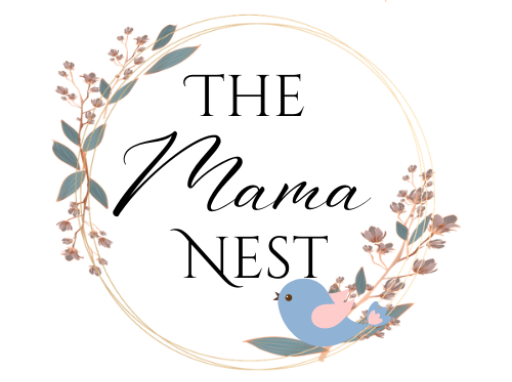

This is very informational! It is different reading to different ages! Love this!
Thank you so much!